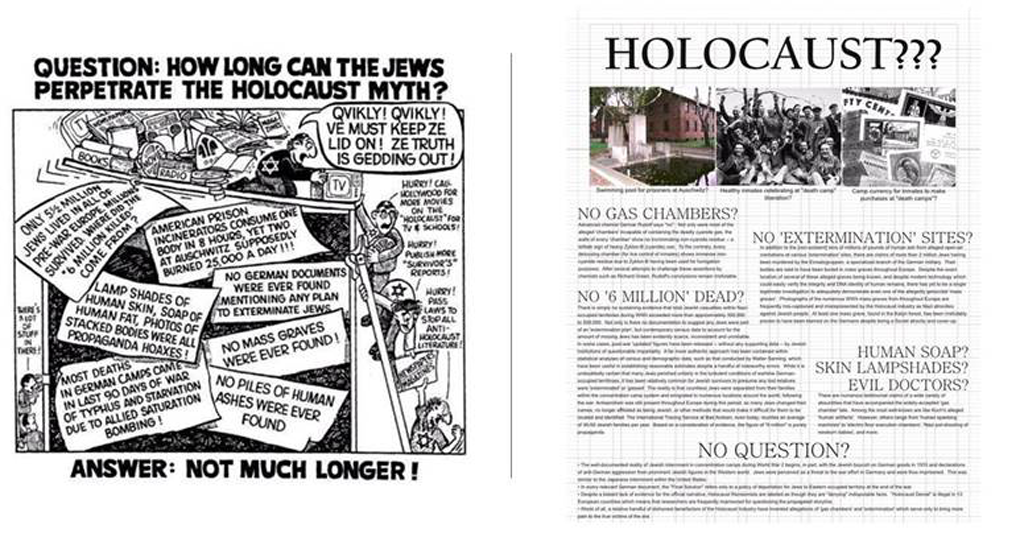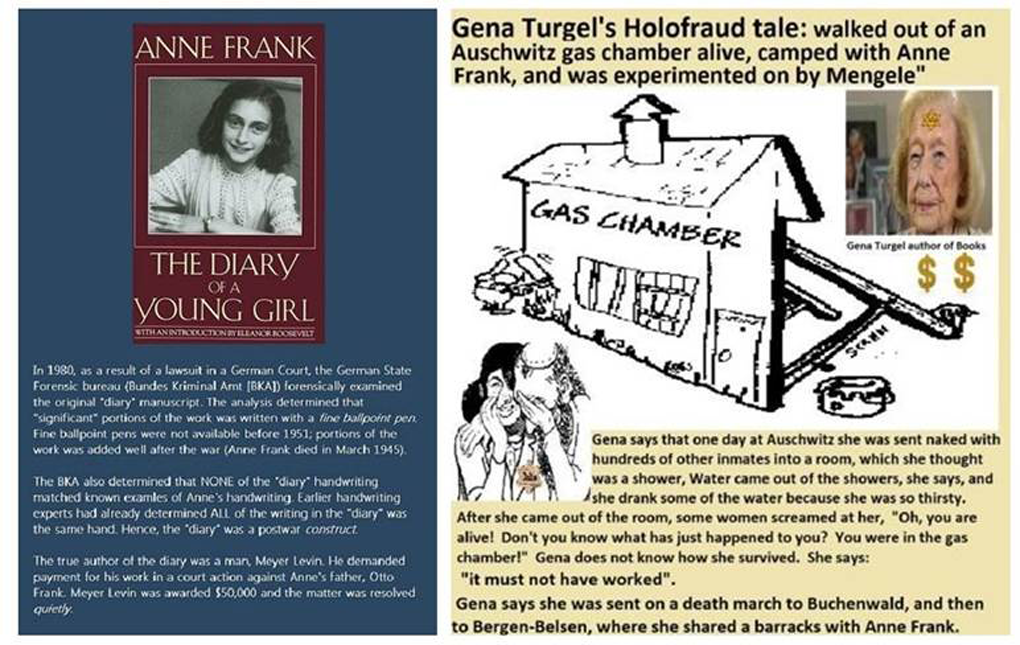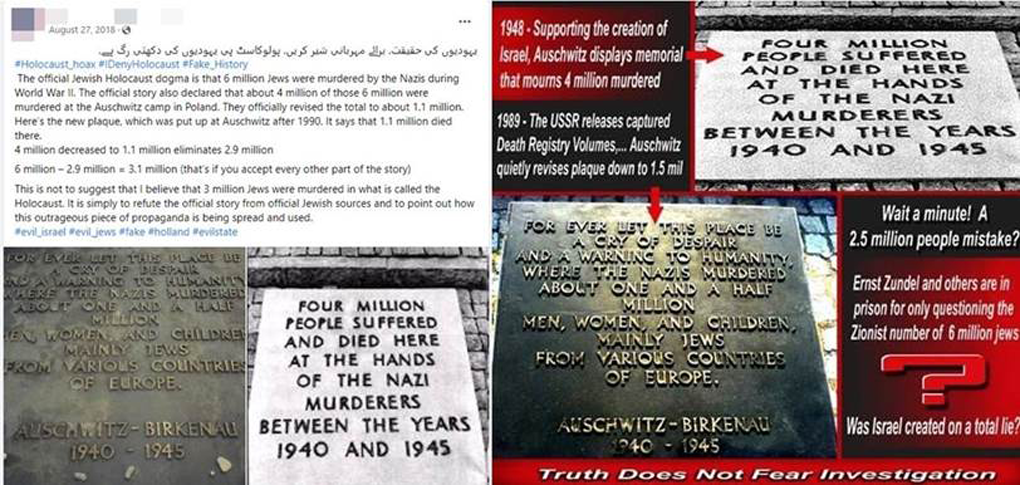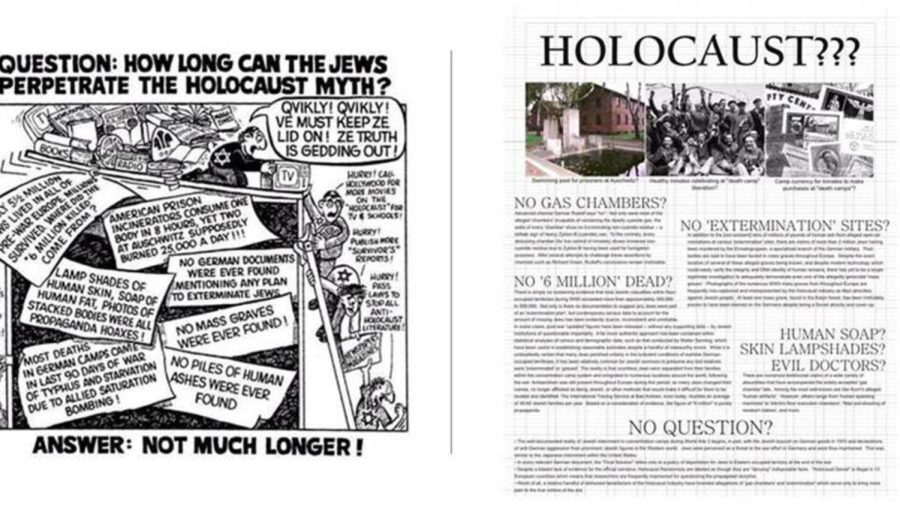
Debunking Holocaust denial claims
Published April 25, 2023
This content first appeared on ADL.org and is republished here with permission.
Holocaust deniers use a range of myths to “prove” the validity of their claims. They share these lies in the texts of pseudo-academic journals, antisemitic and conspiratorial websites and publications and as click-bait memes used by online extremists.
Here are three major Holocaust denial claims — and the facts to debunk them:
ADVERTISEMENT
1. Myth: The Holocaust Did Not Happen Because There Is No Single “Master Plan” for Jewish Annihilation
Although the historical record is full of Nazi-era documents which illustrate the Nazi effort to annihilate Jews in Europe, Holocaust deniers claim that because no one has discovered a single document or master plan that officially and comprehensively sketches out the details of their extermination agenda, the Holocaust must be a hoax. This myth reveals a fundamentally misleading approach to the history of the era.
Holocaust Deniers in their Own Words
“In effect, such a formidable criminal undertaking supposedly conceived, ordered, organized and perpetrated by the Germans would have necessitated an order, a plan, instructions, a budget…Such an undertaking, carried out over several years on a whole continent and generating the death of millions of victims would have left a flood of documentary evidence.” – Robert Faurisson, “The Victories of Revisionism”
“The Nazi ‘Final Solution’ was a plan to forcibly remove, sometimes even by ruthless and brutal means, all Jews from Europe. It was a plan of ethnic cleansing, but not one of total mass extermination…If the plan to murder the Jews was official policy, then we should expect that there would be documentary evidence of this murderous master plan left over in the tons of Nazi documents the Allies captured at the end of WWII.” – Paul Grubach, “The ‘Final Solution of the Jewish Question,’” CODOH, 2007
Deniers Debunked
The lack of a “master document” does not mean that the genocide of European Jews did not occur. The “Final Solution” — the Nazis’ comprehensive plan to murder all European Jews — was, as the Encyclopedia of the Holocaust observes, “the culmination of a long evolution of Nazi Jewish policy.”[1] The destruction process was shaped gradually: it consisted of many thousands of directives, some written and some verbal.[2]
The development and implementation of this process was overseen and directed by the highest tier of Nazi leadership, including Heinrich Himmler, Reinhard Heydrich, Adolf Eichmann, Hermann Goering and Adolf Hitler himself. In the two decades before World War II, Hitler consistently contemplated Jewish annihilation.[3] In a September 16, 1919 letter, he wrote that while “the Jewish problem” demanded an “anti-Semitism of reason” — comprising systematic legal and political sanctions — “the final goal, however, must steadfastly remain the removal of the Jews altogether.”[4]
ADVERTISEMENT
Throughout the 1920s, Hitler maintained that “the Jewish question” was the “pivotal question” for his party and would be solved “with well-known German thoroughness to the final consequence.”[5] With his assumption of power in 1933, Hitler’s racial plans were implemented by measures that increasingly excluded Jews from German society.
On January 30, 1939, Hitler warned that if Jewish financiers and Bolsheviks initiated war, “the result will not be the Bolshevization of the earth, and thus the victory of Jewry, but the annihilation of the Jewish race in Europe.”[6] On, September 21, 1939, after the Germans invaded Poland, the Einsatzgruppen (mobile killing units operating in German-occupied territory) carried out orders to forcibly move Polish Jews into ghettos, alluding to an unspecified “final aim.”[7]
In the summer of 1941, with preparations underway for the German invasion of Russia, large-scale mass murder initiatives — already practiced domestically upon the mentally ill and disabled — were broadly enacted against Jews. On July 31, Heydrich received orders from Goering to prepare plans “for the implementation of the aspired final solution of the Jewish question” in all German-occupied areas.[8]
Subsequent testimony by the architects of the Holocaust corroborates this fact pattern. Eichmann, while awaiting trial in Israel in 1960, related that Heydrich had told him in August 1941 that “the Führer has ordered the physical extermination of the Jews.”[9] Rudolf Höss, the Commandant of Auschwitz, wrote in 1946 that, “in the summer of 1941… Himmler said to me, ‘The Führer has ordered the Final Solution to the Jewish Question… I have chosen the Auschwitz camp for this purpose.’”[10]
On January 20, 1942, Heydrich convened the Wannsee Conference to discuss and coordinate implementation of the Final Solution. Eichmann later testified at his trial: “These gentlemen…were discussing the subject quite bluntly, quite differently from the language that I had to use later in the record. During the conversation they minced no words about it at all…they spoke about methods of killing, about liquidation, about extermination.”[11]
Ten days after the conference, in a speech at the Sports Palace in Berlin that was recorded by the Allied monitoring service, Hitler declared: “The result of this war will be the complete annihilation of the Jews…the hour will come when the most evil universal enemy of all time will be finished, at least for a thousand years.”[12] On February 24, 1943, he stated: “This struggle will not end with the annihilation of Aryan mankind, but with the extermination of the Jewish people in Europe.”[13] The overwhelming thrust of written documentation, verbal testimony, demographic research and archaeological evidence demonstrate that Holocaust deniers‘ demand for a document that lays out the Nazis‘ “master plan” is a deliberate effort to obfuscate the truth.

2. Myth: Holocaust Scholars Rely on the Testimony of Survivors Because There Is No Objective Documentation Proving the Nazi Genocide
Another frequent claim of Holocaust deniers, who often refer to themselves as “revisionists,” concerns what they describe as the lack of “objective” documentation proving the facts of the Holocaust, and the reliance by scholars on what they deem as biased and poorly recollected testimonies of survivors. Deniers will focus on minute details of survivor testimony to try to disprove their accounting — and the Holocaust itself — writ large.
Holocaust Deniers in their Own Words
“Inevitably when anyone questions the genocide of European Jewry, eyewitness testimony is raised as proof that the genocide happened…The eyewitness accounts of the Holocaust story have proved to be extremely unreliable and ineffective in proving its validity.” – John Wear, “Eyewitness Testimony to the Genocide of European Jewry,” Inconvenient History Journal, Vol. 12 No. 1, 2020
“I think a lot of the Holocaust survivors, they didn’t know nothing anything about what happened during that time period except their own being in a camp, a work camp or whatever. The movies from Hollywood produced about what they wanted everybody to believe what happened here. And then these holocaust survivors, they’re watching the movies and they’re believing what they’re seeing in the movie and they’re incorporating it in their life…they can write books and they can be interviewed to go to the schools or whatever, telling their nonsense about the [Holocaust]” – Jim Rizoli, Bitchute video, August 2022
Deniers Debunked
The Germans left no shortage of documentation and testimony to the events of World War II, and no serious scholar has relied solely on survivor testimony as the conclusive word on Holocaust history.
As Lucy Dawidowicz wrote in the preface to her authoritative work, The War Against the Jews 1933-1945: “The German documents captured by the Allied armies at the war’s end have provided an incomparable historical record, which, with regard to volume and accessibility, has been unique in the annals of scholarship…The National Archives and the American Historical Association jointly have published 67 volumes of Guides to German Records Microfilmed at Alexandria, VA. For my work I have limited myself mainly to published German documents.”[14]
The author lists 303 published sources — excluding periodicals — which document the conclusions of her research. Among these sources are the writings of recognizable Nazi policy makers such as Adolf Hitler, Heinrich Himmler, Rudolf Höss and Alfred Rosenberg.
Similarly, as Raul Hilberg wrote in his three-volume edition of The Destruction of the European Jews, “between 1933 and 1945 the public offices and corporate entities of Nazi Germany generated a large volume of correspondence. Some of these documents were destroyed in Allied bombings, and many more were systematically burned in the course of retreats or in anticipation of surrender. Nevertheless, the accumulated paperwork of the German bureaucracy was vast enough to survive in significant quantities, and even sensitive folders remained.”[15] It is thus largely from these primary sources that the history of the Holocaust has been compiled.
A more recent factor in this process of reconstructing the historical record was the additional availability of countless records from the former Soviet Union, many of which had been overlooked or suppressed since their capture at war’s end by the Red Army until the fall of the Soviet Union. Beyond the work conducted by scholars, primary source records corroborating the historical record of the Holocaust are also increasingly available to the general public via increased digitization efforts by many of the world’s major archival institutions.
Needless to say, the modification of specific details in this history is certain to continue for a number of years to come, considering the vastness and complexity of the events which comprise the Holocaust. However, it is equally certain that these modifications will only confirm the Holocaust’s enormity, rather than — as the “revisionists” would — call it into question.

3. Myth: The Auschwitz Plaques Prove that the Six Million Figure is False
Another myth employed by Holocaust deniers bent on “disproving” the accepted historical fact that six million Jews were murdered in the Holocaust is to claim that the memorial plaques installed at the infamous Auschwitz concentration and extermination camp complex show that figure is wildly exaggerated. These claims, however, rely on an intentional misrepresentation of the history and context of the numbers listed on these plaques.
Auschwitz, the largest Nazi extermination camp complex during World War II, played a key role in the implementation of the Nazis’ deadly “final solution.”[16] After Russian soldiers liberated the camp in 1945, a Soviet investigation concluded that four million people had died at Auschwitz during the war.[17] This number was presented during the prosecution of former Nazi officials at the Nuremberg Trials and was enshrined in a large plaque on the grounds of the notorious camp when the Polish government converted Auschwitz into a museum in 1947.[18]
In 1990, however, the museum removed the plaque from display.[19] The museum’s historian, Franciszek Piper, announced that the number of Auschwitz victims was about 1.5 million, not four million.[20] Eventually a new plaque was installed representing the new, lower figure.
Deniers claim that the information listed on the new plaque and acknowledgement of the past miscalculation is “proof” that the facts of the Holocaust have been exaggerated. They allege that the reduction of the Auschwitz death toll to 1.5 million should have resulted in a corresponding reduction of the six million figure down to 3.5 million.
Holocaust Deniers in their Own Words
“Auschwitz is central to the Holocaust legend. If it can be proved that the official stories we have been told about Auschwitz are not true, the entire fabric of the Holocaust ultimately has to unravel…History books had said for a generation that of the 6 million Jews who died during the Holocaust, 4 million died at Auschwitz alone. Thus, if the new facts were correct, the actual overall number of Jewish Holocaust victims had to be considerably less than the much-talked-about figure of 6 million. Put simply: subtract the former 4 million Jews dead at Auschwitz from the popular 6 million, and that leaves 2 million Jews dead. Simple math – and a controversial conclusion indeed.” – Michael Collins Piper, “Auschwitz: The Final Count,” The Barnes Review (vol. 5 no. 5), 1999
“Only the Jew won world war two. His victory allowed him to make the bogus claim that six million jews were slaughtered. That is a lie, and a big one. The plaque at Auschwitz originally claimed four million were killed there. Today that plaque reads 1.5 million. No correction has been made to the official six million figure…They’re still exaggerating the number of deaths, but, for now, what happened to that 2.5 million? The plaques exist. There are pictures of them. WHAT HAPPENED TO THOSE 2.5 MILLION PEOPLE?…The simple fact of that matter is that the ‘six million jews murdered by Nazis’ is a Big Lie [all sic].” – Alex Linder, “Interview with Contentious Times,” Vanguard News Network, 2005
“Over the years, the numbers of ‘dead’ in Auschwitz have changed drastically. Hardly anyone can keep the lie straight any more…Pick your favourite number – facts don’t matter, truth does not matter, death certificates don’t matter to the Holocaust-promoters and -liars! Anti-German propaganda is the only thing that seems to matter in this racket!” – Ernst Zundel, Zundelsite
Deniers Debunked
Holocaust deniers’ claims about the death figures at Auschwitz and in the Holocaust more broadly ignore key facts about the installation and revision of the memorial plaques.
The initial four million figure inscribed on the Auschwitz plaques was reported by the Soviet Union and was generally accepted in Soviet-controlled countries, including Poland, until the 1990s.[21] Western scholars, however, had long rejected the figure as anti-Western propaganda not supported by the evidence, and placed the total number of Auschwitz casualties between one and two million.[22] It was these same Western scholars who had originally estimated the total number of Jews killed in the Holocaust at approximately six million.[23]
When the Auschwitz-Birkenau State Museum formally rejected the four million figure in the early 1990s (following Poland’s emergence from communism in 1989), it was abandoning a number that many scholars had already rejected decades before. By acknowledging that casualties at the camp were between 1.1 and 1.5 million, the museum was in fact affirming the statistic that had helped Western scholars arrive at the approximation of six million lives lost.
In the early 1990s, several major newspapers and wire services reported on the museum’s decision to reject the four million figure — including the New York Times,[24]Washington Post [25] and Chicago Tribune.[26] All noted that the figure was the product of Soviet propaganda, and that by rejecting it the museum was moving into the realm of objective Holocaust research.

















